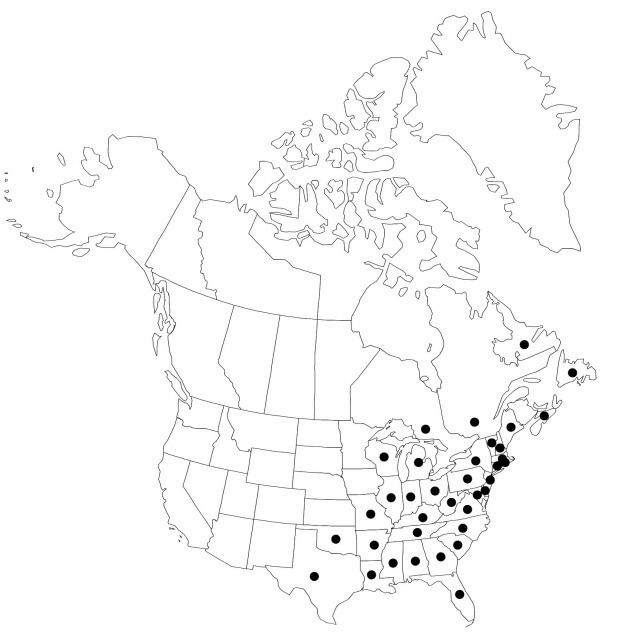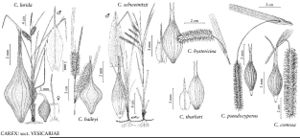Difference between revisions of "Carex lurida"
Kongl. Vetensk. Acad. Nya Handl. 24: 153. 1803.
FNA>Volume Importer |
FNA>Volume Importer |
||
| Line 24: | Line 24: | ||
|elevation=0–1200 m | |elevation=0–1200 m | ||
|distribution=Nfld. & Labr.;N.S.;Ont.;Que.;Ala.;Ark.;Conn.;D.C.;Fla.;Ga.;Ill.;Ind.;Ky.;La.;Maine;Md.;Mass.;Mich.;Miss.;Mo.;N.H.;N.J.;N.Y.;N.C.;Ohio;Okla.;Pa.;R.I.;S.C.;Tenn.;Tex.;Vt.;Va.;W.Va.;Wis.;Mexico;West Indies;South America. | |distribution=Nfld. & Labr.;N.S.;Ont.;Que.;Ala.;Ark.;Conn.;D.C.;Fla.;Ga.;Ill.;Ind.;Ky.;La.;Maine;Md.;Mass.;Mich.;Miss.;Mo.;N.H.;N.J.;N.Y.;N.C.;Ohio;Okla.;Pa.;R.I.;S.C.;Tenn.;Tex.;Vt.;Va.;W.Va.;Wis.;Mexico;West Indies;South America. | ||
| − | |discussion=<p>Carex lurida is an abundant, variable, and often weedy species. A few specimens appear to be hybrids of C. lurida with C. lupulina.</p> | + | |discussion=<p><i>Carex lurida</i> is an abundant, variable, and often weedy species. A few specimens appear to be hybrids of <i>C. lurida</i> with <i>C. lupulina</i>.</p> |
|tables= | |tables= | ||
|references= | |references= | ||
| Line 48: | Line 48: | ||
|publication year=1803 | |publication year=1803 | ||
|special status= | |special status= | ||
| − | |source xml=https://jpend@bitbucket.org/aafc-mbb/fna-data-curation.git/src/ | + | |source xml=https://jpend@bitbucket.org/aafc-mbb/fna-data-curation.git/src/8f726806613d60c220dc4493de13607dd3150896/coarse_grained_fna_xml/V23/V23_946.xml |
|genus=Carex | |genus=Carex | ||
|section=Carex sect. Vesicariae | |section=Carex sect. Vesicariae | ||
Revision as of 16:12, 18 September 2019
Plants densely to loosely cespitose; rhizomes short, no more than 10 cm. Culms sharply trigonous in cross section, (15–)25–95(–110) cm, scabrous-angled distally. Leaves: basal sheaths reddish purple; ligules as wide to slightly longer than wide; blades dark green, flat to W-shaped, widest leaves (4–)4.5–11.5(–13) mm wide, glabrous. Inflorescences 2.7–18 cm; proximal bract 9–45 cm, exceeding inflorescence; proximal 1–3(–4) spikes pistillate, erect or the proximal often spreading, (12–)15–22 mm thick, if spikes less than 15 mm thick, then usually less than 2.5 times as long as wide; terminal 1 spike staminate. Pistillate scales narrowly oblong, 3.4–11.2 × 0.5–1.1 mm, as long as or shorter than perigynia, margins often ciliate, apex truncate to retuse, erose, prolonged to scabrous awn. Staminate scales with distinct, scabrous awn, sometimes ciliate-margined. Perigynia spreading, strongly 7–12-veined, veins separate nearly to beak apex, broadly ovate, (6–)6.5–10.8 × (1.8–)2–3.5(–4.2), apex contracted; beak 2.5–5.9 mm, 0.7–0.9 length of body, bidentate, smooth, teeth straight, to 0.2–0.8 mm. Stigmas 3. Achenes yellow to brown, trigonous, papillose.
Phenology: Fruiting May–Aug.
Habitat: Wet meadows, marshes, seeps, shores of ponds, lakes, and streams, open swamp forests, ditches, mostly in acidic, often sandy soils
Elevation: 0–1200 m
Distribution

Nfld. & Labr., N.S., Ont., Que., Ala., Ark., Conn., D.C., Fla., Ga., Ill., Ind., Ky., La., Maine, Md., Mass., Mich., Miss., Mo., N.H., N.J., N.Y., N.C., Ohio, Okla., Pa., R.I., S.C., Tenn., Tex., Vt., Va., W.Va., Wis., Mexico, West Indies, South America.
Discussion
Carex lurida is an abundant, variable, and often weedy species. A few specimens appear to be hybrids of C. lurida with C. lupulina.
Selected References
None.
